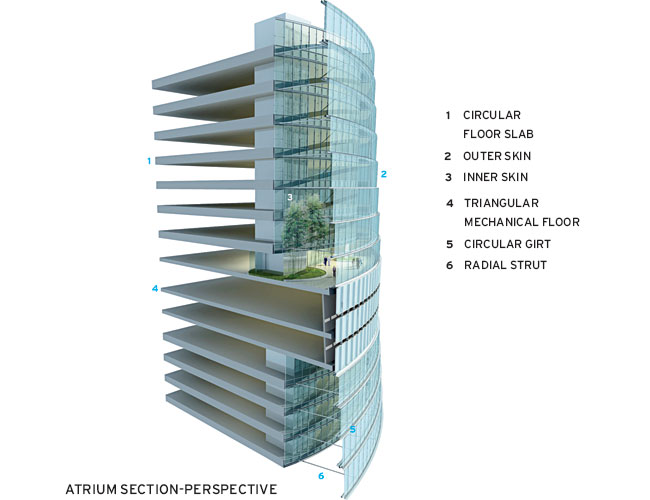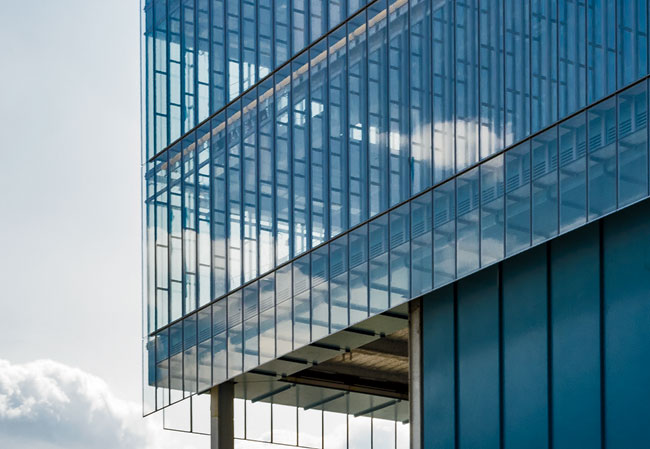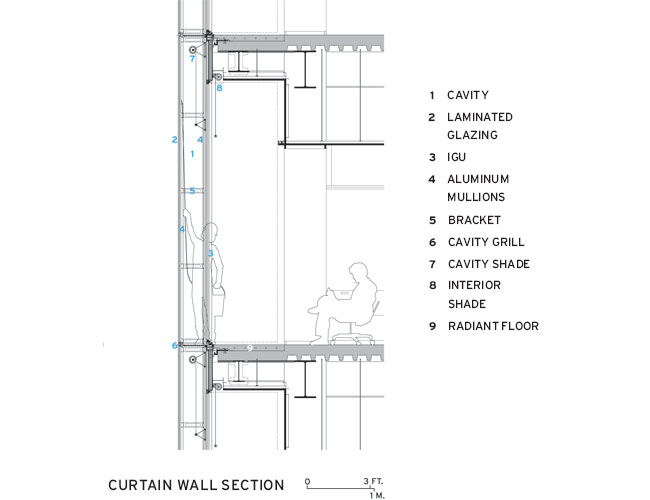Innovations in Glass
Continuing Education: Double-Skin Buildings
Thick-Skinned: Two very different buildings deploy double curtain walls to satisfy the competing demands of transparency, efficiency and comfort.












One of the highest-profile double-skin buildings under construction now is Gensler's tapering and twisting Shanghai Tower. At 121 stories and 2,073 feet, it will be the world's second-tallest skyscraper when completed later this year. The building, which includes office space, a hotel, and a conference center, is organized like a tiered wedding cake: nine cylinders with gradually smaller diameters'each between 12- and 15-floors tall'are stacked one on top of the other. Between each zone, triangular two-story mechanical floors serve as platforms for 21 public atria or 'gardens in the sky,' enclosed by the tower's outer and inner curtain walls.
The outer skin, which helps define the skyscraper's serpentine form, consists of laminated glass within aluminum extrusions supported by radial struts and encircling girts. The inner skin's aluminum curtain wall, supported by the office and hotel floors' circular slabs, is made up of insulated glass units (IGUs).
The atria in between the two layers will do more than offer office workers a place to eat lunch. The spaces will also perform as a climatic buffer, explains Alan Hung, a principal at Cosentini Associates, the tower's mechanical engineer. These spaces will be maintained at temperatures that are cooler than the outdoors in summer by taking advantage of so-called 'spill air': used air from the tower's interior that will be recirculated through atrium. In the winter, when the recirculated air is warmer than outdoor temperatures, the strategy will reduce the amount of heating needed. And since only the lowest 8 feet of each roughly 190-foot-tall atrium is occupied, the space can be kept comfortable 'with very little energy input,' points out Benedict Tranel, a Gensler principal.
In New York, architects from Renzo Piano Building Workshop (RPBW) are using a double skin to enclose the Jerome L. Greene Science Center'a 9-story, 450,000-square-foot neuroscience lab under construction on Columbia University's new campus in northern Manhattan. Here the skin is the logical result of the 17-acre academic precinct's master plan designed by RPBW and Skidmore, Owings & Merrill which is intended to be permeable to the neighborhood around it. The plan has such features as publicly accessible green spaces and ground-floor retail. 'The transparent building envelope is an extension of this philosophy,' says Philip Pitruzzello, Columbia's vice president in charge of the new campus's development.
Though RPBW's building is shorter and has a different program from Gensler's tower, the composition of its curtain-wall elements is similar, though not identical. The envelope's outer skin consists of laminated glass, while the inner one is an IGU, albeit one with an interior-facing lite that is laminated. This additional layer helps keep out sounds such as the rumbling of a train that passes by the building on elevated tracks, explains Mic Patterson, vice president at Enclos, the curtain wall's fabricator and installer.
The primary difference between the configuration of the curtain walls on the two buildings is the distance between the inner and outer skin. In New York they are separated by only a 16-inch cavity rather than by occupiable space, a cavity just wide enough to house automated shades that prevent solar gain (the building will also have interior automated shades to mitigate glare). Like Shanghai's atria, although much narrower, the cavity still makes use of spill air to create a thermal buffer. The strategy is especially appropriate for labs because of their high ventilation requirements, points out Scott Frank, a partner at Jaros, Baum & Bolles, the project's mechanical engineer. This air, which would typically be vented from the building, is essentially a 'free resource,' he says.
Because of the buffer that the envelope system provides'along with a host of other features, including heat recovery, state-of-the-art lighting controls, and chilled beams'Columbia's new lab building is expected to be about 30 percent more efficient than required by code. For the Shanghai Tower, such savings are predicted to be about 21 percent. But efficiency isn't the only reason to use a double curtain wall'at least not for Gensler's Tranel. 'It provides the opportunity to create something spatial,' he says. 'It's an architectural solution rather than a technical one."

To earn one AIA learning unit (LU), including one hour of health, safety, and welfare (HSW) credit, read each of the articles below and complete the test online. Upon passing, you will receive a certificate of completion and your credit will automatically be reported to the AIA. Find additional information regarding credit-reporting and continuing-education requirements at ce.construction.com, under “requirements.”
Innovations In Glass
- Straight Story On Curves
- Reflections on the Box
- Bigger, Flatter, Clearer
- Dynamic Glass
- The Future Is Crystal Clear
Learning Objectives
- Discuss glass manufacturing processes as well as fabrication options and limitations that architects should take into account while designing glazed building skins.
- Define terms relevant to glass and glazing selection, such as VLT, U-value, and solar heat gain coefficient.
- Discuss how architects like SANAA and Foster + Partners have overcome the detailing challenges presented by curved glass.
- Describe how technologies such as electrochromic glazing and double skins work to improve energy efficiency.
AIA/CES Course K1503A
Take the Continuing Education Test










